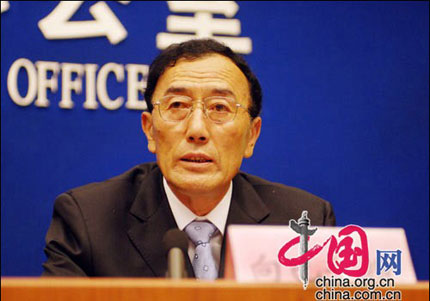Tibetans against Dalai Lama's return
(Xinhua)Updated: 2007-06-20 16:41
 Qiangba Puncog, chairman of the regional government of Tibet Autonomous Region, speaks at a press conference in Beijing June 20, 2007. [china.org.cn]  |
Qiangba Puncog, chairman of the regional government, was asked to comment, at a press conference in Beijing, on two letters written by Puncog Wanggyai, a member of the Communist Party in Tibet, to Chinese President Hu Jintao in 2004 and 2005 asking for permission to let the Dalai Lama come back to Tibet. He was asked if the letters represented the view of the majority of the Tibetan people.
"I have not seen the letters but I have heard about the content. The content I know about differs greatly from the common opinions held by the majority of the Tibetan people," he said.
"His (Puncog Wanggyai) opinion does not represent the view of the majority of Tibetan people, nor does it represent views of the majority of officials in Tibet. It only represents a handful of people," said Puncog.
"The Dalai Lama travels around the world in Buddhist robes not for religious matters but to make Tibet issue an international one and to realize his own political purposes," he said.
He said the Dalai Lama's pursuit of autonomy or establishment of the greater Tibetan area actually disguised his pursuit of independence.
"People from the Dalai Lama side believe, 'once this succeeds, independence is not far away', and this reveals what they really want to do," he said.
Puncog said the channel of communication with the Dalai Lama and his personal representative has always been open. "I think the key question lies in the Dalai Lama giving up the claims of independence and separatist activities," he said, "we all expect him to show his sincerity and truly do some good deeds for the Tibetan people and the country during his lifetime."
Tibet not 'assimilated' by the Han people
At
the press conference, Puncog said the Tibetan people will not be
assimilated by the Han culture.
Of the 2.8 million residents in Tibet, 92
percent are of Tibetan nationality, 5 percent Han people and the other 3 percent
of other ethnic origin, said Qiangba Puncog.
"The customs and traditional
festivals also remain unchanged after millions of tourists flock there following
the central government's large amount investment in the region," he
said.
"Today I wear a suit instead of the traditional costume of Tibetan
because it is more convenient in daily life. This should not be held as evidence
of 'Hanizing'. The Han people don't wear long robes either," he said.
"There are more than 1,700 religious sites and over 40,000 monks and
nuns living in monasteries throughout the region. Various religious activities
are held regularly," he said.
The region also plans to allocate hundreds
of millions yuan to maintain and renovate a group of world heritage sites and
major cultural relics in the next five years, said the official.
"It's
the Tibetan people who directly benefit from the investment," he said.
Tibetan have seen improvement in housing and they now have easy access
to electricity and clean drinking water, and Tibetan kids enjoy free education,
thanks to the financial support from the central government and other provinces
in the country, said the official.
The central government of China will
invest 77.8 billion yuan in 180 projects in Tibet in the 2006-2010 period to
improve infrastructure and the living conditions of farmers and
herders.
|
||
|
||
|
|